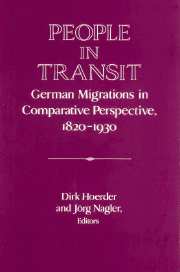Book contents
- Frontmatter
- Introduction
- PART I CONTINUITY AND COMPLEXITY: MIGRATIONS FROM EAST ELBIAN GERMANY AND GALICIAN POLAND
- Part II Internal German Migrations and In-Migrations
- PART III WOMEN'S MIGRATION: LABOR AND MARRIAGE MARKETS
- 10 The International Marriage Market: Theoretical and Historical Perspectives
- 11 Making Service Serve Themselves: Immigrant Women and Domestic Service in North America, 1850-1920
- 12 German Domestic Servants in America, 1850-1914: A New Look at German Immigrant Women's Experiences
- 13 Acculturation of Immigrant Women in Chicago at the Turn of the Twentieth Century
- PART IV ACCULTURATION IN AND RETURN FROM THE UNITED STATES
- 18 Migration Past and Present - The German Experience
- 19 Research on the German Migrations, 1820s to 1930s: A Report on the State of German Scholarship
- Index
13 - Acculturation of Immigrant Women in Chicago at the Turn of the Twentieth Century
Published online by Cambridge University Press: 05 January 2013
- Frontmatter
- Introduction
- PART I CONTINUITY AND COMPLEXITY: MIGRATIONS FROM EAST ELBIAN GERMANY AND GALICIAN POLAND
- Part II Internal German Migrations and In-Migrations
- PART III WOMEN'S MIGRATION: LABOR AND MARRIAGE MARKETS
- 10 The International Marriage Market: Theoretical and Historical Perspectives
- 11 Making Service Serve Themselves: Immigrant Women and Domestic Service in North America, 1850-1920
- 12 German Domestic Servants in America, 1850-1914: A New Look at German Immigrant Women's Experiences
- 13 Acculturation of Immigrant Women in Chicago at the Turn of the Twentieth Century
- PART IV ACCULTURATION IN AND RETURN FROM THE UNITED STATES
- 18 Migration Past and Present - The German Experience
- 19 Research on the German Migrations, 1820s to 1930s: A Report on the State of German Scholarship
- Index
Summary
The research reported in this essay grows out of the project “Women in the Migration Process” - a comparative analysis of German, Irish, Swedish, and Polish women in Chicago at the turn of the century. The aim of the project has been to determine the role of women in the migration process in the second half of the nineteenth century. Its emphasis throughout has been on the transfer of culture. Hence the project follows the women from Europe to North America and analyzes the structures of the sending as well as the receiving culture, the options open to them, the incentives and structures that fostered the decision to migrate, and the adaptations and change of their roles in the process of migration.
The geographical focus of the study is Chicago, the second largest metropolitan area of the United States at the beginning of the twentieth century. This city experienced rapid industrial development during the latter half of then nineteenth and the early twentieth centuries. The consequent number and range of job opportunities in the city were a magnet for male and female migrants. By 1860 almost half of the city's population was foreign-born and by 1900, the period of this study, 77.3 percent of the white population comprised immigrants of the first and second generations. The four ethnic groups studied represent the four largest groups in the city at the turn of the century. The Germans were by far the largest group with 31.5 percent, followed by the Irish with 15.7 percent, the Poles with 9.3 percent, and the Swedes with 8.3 percent. Together they accounted for 64.8 percent of the immigrant population.
The justification for focusing on these four groups lies not only in their numerical representation but also in the fact that all four countries of origin experienced significant out-migration to the United States. The demographic and socioeconomic composition of the migrant streams from these countries differed as did their reasons for leaving, though there were a number in common. The timing of their arrival in Chicago varied as well. By 1900 both the Germans and Irish were well established and into the second generation while the Poles were only at the beginning of their history in Chicago. Hence the ethnic communities were at different stages in their development and occupied different niches in Chicago's occupational and social structure. How these differences and those in the culture of origin affected the acculturation of the four different groups of female migrants is the main focus of the study.
- Type
- Chapter
- Information
- People in TransitGerman Migrations in Comparative Perspective, 1820–1930, pp. 295 - 310Publisher: Cambridge University PressPrint publication year: 1995



